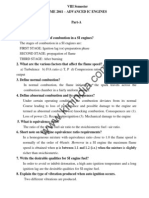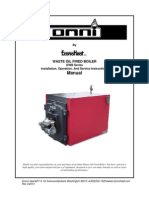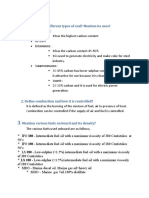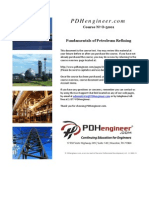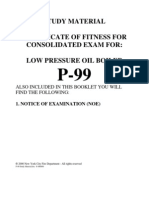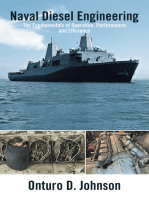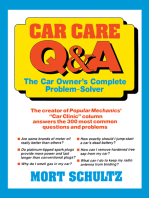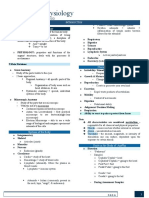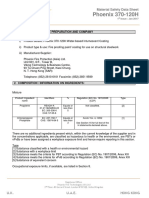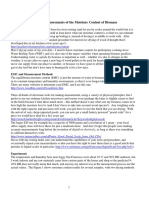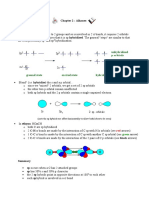Supervise Fuel-Oil Piping and Storage in Buildings: Study Material Certificate of Fitness For
Supervise Fuel-Oil Piping and Storage in Buildings: Study Material Certificate of Fitness For
Uploaded by
hothiminhanhCopyright:
Available Formats
Supervise Fuel-Oil Piping and Storage in Buildings: Study Material Certificate of Fitness For
Supervise Fuel-Oil Piping and Storage in Buildings: Study Material Certificate of Fitness For
Uploaded by
hothiminhanhOriginal Title
Copyright
Available Formats
Share this document
Did you find this document useful?
Is this content inappropriate?
Copyright:
Available Formats
Supervise Fuel-Oil Piping and Storage in Buildings: Study Material Certificate of Fitness For
Supervise Fuel-Oil Piping and Storage in Buildings: Study Material Certificate of Fitness For
Uploaded by
hothiminhanhCopyright:
Available Formats
FIRE DEPARTMENT CITY OF NEW YORK
STUDY MATERIAL CERTIFICATE OF FITNESS FOR
SUPERVISE FUEL-OIL PIPING AND STORAGE IN BUILDINGS
P-98
ALSO INCLUDED IN THIS BOOKLET YOU WILL FIND THE FOLLOWING: NOTICE OF EXAMINATION (NOE)
2008 New York City Fire Department - All rights reserved
P-98 Study Material.doc 06/2008
NOTICE OF EXAMINATION FOR Title: Consolidated Examination for the Certificate of Fitness for City Wide Fuel-Oil Piping and Storage System (P 98- W98)
Date of Test: Written tests are conducted Monday to Friday (except legal holidays) 9:00 AM to 2:30 PM.
QUALIFICATION REQUIREMENTS
1. Applicants must be at least 18 years of age. 2. Applicants must have a reasonable understanding of the English language. 3. Applicants must present a letter of recommendation from his/her employer, trade school or trade union. The letter must be on official letterhead and must state the applicants full name, character, physical condition, experience, and address of premises where applicant will be employed. Self-employed applicants must submit a notarized letter. 4. Applicants must present two (2) forms of satisfactory picture identification i.e., drivers license and passport ID pictures. APPLICATION INFORMATION Application Fees: $25.00 for originals and $15.00 for renewals. The fee may be paid in cash, money order, or personal check payable to New York City Fire Department. The $25.00 fee must be payable by all applicants prior to taking the Certificate of Fitness test. Application forms are available at the Public Certification Unit, 1st floor, 9 MetroTech Center, Brooklyn, NY 11201. TEST INFORMATION Test: The test will be of the written, multiple choice type. A passing score of at least 70% is
required in order to obtain a Certificate of Fitness. Individuals holding a Certificate of Competence as a Boiler Inspector from the NYS Dept. of Labor; or a license as a High Pressure Boiler Operating Engineer or a license as an Oil Burning Equipment Installer from the NYC Dept. of Buildings may have the written test waived and receive a COF via the Alternative Issuance Policy. Call (718) 999-2482 for additional information and forms.
2008 New York City Fire Department All rights reserved
Consolidated P-98 NOE.doc 050200
This Study Material contains some of the information you will need to prepare for the Consolidated examination for the certificate of Fitness for Supervision of Fuel Oil Piping And Storage System (P98). The study material includes information taken, for the most part, from relevant sections of the Building Code of New York. Other information describes the proper operation and maintenance of Fuel oil piping and storage systems. All questions on the Certificate of Fitness examination are multiple choice, with four alternative answers to each question. Only one answer is correct for each question. If you do not answer a question or if you mark more than one alternative your answer will be scored as incorrect. A score of 70% correct is required on the examination in order to qualify for the Certificate of Fitness. Read each question carefully before marking your answer. There is no penalty for guessing. Sample Questions
_____1. What is the capital of the United States? (A) Washington D.C. (B) Albany (C) Trenton (D) Providence The correct answer is A. You would press A on your touch-screen monitor. _____2. The United Nations building is located in: (A) Queens. (B) Manhattan. (C) Washington D.C. . (D) Los Angeles. The correct answer is B. You would mark B on your touch-screen monitor.
OIL BURNER OPERATION
Combustion is the chemical union of the oxygen in the air with combustible elements in the fuel-oil (hydrogen and carbon). The end result of this process is the production of heat energy. Oil firing equipment is used to liberate heat energy from the fuel-oil. Oil burners are the principal components of the oil firing equipment and provide the means of supporting the process of combustion. Carbon and hydrogen are the two principal elements of fuel oil. During the combustion process, the carbon content of the fuel-oil (about 85%) unites with the oxygen in the air and forms carbon dioxide and carbon monoxide. The hydrogen content of the oil (about 14%) unites with the oxygen and produces water. The objective is to have a complete combustion process. This objective is met when the fuel-oil combines with the greatest possible amount of oxygen. Oil is a liquid fuel and as such will not burn. It must be changed to a gas or vapor and mixed with air in order to support combustion. The oil burner is primarily a device for processing the liquid fuel for combustion by accelerating the change from liquid to a vapor that can be mixed with air and burned. This process of breaking down or atomizing the oil is necessary to ensure prompt ignition and rapid combustion. Although there are various types of oil burners, i.e. generator or boiler, they all vaporize or atomize the oil before it enters the combustion chamber where it is mixed with air in predetermined proportions. The oil burner uses an oil pump and mixes air and oil within the nozzle itself. In oil burners, the oil and air mixture is delivered to the nozzle at a pressure dependent upon the make of the burner. The air that contacts the oil prior to its leaving the nozzle is referred to as primary air. The introduction of air from the blower or fan into the combustion chamber after the oil has left the nozzle is referred to as secondary air. Every brand of oil burner is essentially unique and different from that of other manufacturers. Diesel generators use injection nozzles without primary air Thus it is important that an operator of a system understand the functions of his/her particular system completely Oil burners require approximately 2000 cubic feet of air per gallon of oil consumed. The mixture of oil and air is sprayed in vapor form into a firebox area (the combustion chamber) where combustion takes place. The mixture of air and fuel in the burner must be strictly controlled. Poor mixture could become an explosive mixture. During the process of combustion, one part of carbon unites with two parts of oxygen to produce carbon dioxide (CO2). Each time one pound of carbon is burned, 14,544 BTU of heat are liberated. Carbon dioxide is recognized as the end product of complete combustion. Should the fuel be supplied without the proper amount of oxygen, then carbon dioxide and soot will be produced It will be produced at 4,480 BTU at heat liberated. Carbon monoxide is recognized as the end product of incomplete combustion. In addition to being inefficient in the production of heat, the presence of carbon monoxide is highly dangerous. If the proper amount of air has been thoroughly mixed with the oil, and the temperature of the flame is correct, the free carbon burns completely. A correctly adjusted oil burner flame will have an orange-colored flame body with small red tips. These tips will be slightly cloudy. A red, smoky flame is an indication of a lack of air. A white, almost dazzling flame is an indication of a great amount of excess air. An insufficient air supply is one cause of dense, black smoke and soot; an excessive air supply can blow out the flame. The oil spray entering the combustion chamber burns in suspension. If any part of the spray mixture contacts the walls of the combustion chamber, it will cause a smoky fire. Over a period of time carbon deposits may build up in the combustion chamber and cause a burner failure. 4
Insulating firebrick makes up the walls of the combustion chamber. Insulating firebrick is lightweight firebrick that becomes cherry red 15 seconds after the burner starts. The refractory material in the combustion chamber should be closed to the flame and the oil should be burned by the reflected heat. Reflected heat, which increases combustion efficiency, is heat that is reflected back into the combustion chamber and maintains the fire after the ignition is turned off. 1. Diesel generators operate differently. They have an internal combustion engine. Air is compressed by a piston and diesel fuel is injected into the cylinder. The mixture ignites and turns the engine. Insufficient compression air or clogged ignition nozzles will result in improper combustion. The output will be black smoke and excessive vibration of the engine. 2. Generators are used as emergency power supply if the grid fails. It range from 1k VA - 10k VA for small portable diesel while 8kVA 2000k VA for large office complexes, factories and power stations. Diesel generators also provide back up power to utility grids. Power failures are particularly critical for hospitals and large offices, and computer service centers have emergency power generators which are typically powered by diesel fuel and configured to start automatically, as soon as a power failure occurs. Power generators are selected based on the load they are intended to supply power for, Ideally diesel engines should run at least around 60- 75% of their maximum rated load, and at around 75% of their maximum speed and must be test run at every month to avoid damage under certain conditions that are sometimes encountered when an engine is left idling as a standby generating unit ready to run up when needed Fuel-oil comes in several grades, from range oil or no. 1 fuel oil, to diesel oil or no. 2 fuel oil; to the heavier no. 4, no. 5, and no. 6 fuel-oils. Strainers and or filter are required in the oil line to separates out dirt and sediment. Approval from the NYC Department of Buildings and FDNY is required before changing any grade of fuel-oil. Several conditions can lead to improper operation of the oil burner system and to possibly dangerous situations: 3. A defective oil cut-off valve can lead to after-drip. This is a very common condition. The oil drips into the combustion chamber when the burner is off, and the excessive oil is absorbed by the combustion chamber floor and walls. This causes the burner to be unusually noisy when it starts up or shuts down. It will eventually lead to a carbon deposit build-up and to a less efficient operation of the burner. Afterdrip is also dangerous in that it may lead to fire on the floor in front of the heating unit. 4. A leaking seal on the oil pump shaft bearing may also cause oil to leak on the floor in front of the heating unit. The leaked oil could become ignited also. 5. Dirty or damaged nozzles or rotary cups can cause improper atomization. This will eventually lead to a carbon deposit build-up in the combustion chamber. 6. Blockage in the chimney or flue passage will cause the cellar or boiler room to become filled with smoke. 7. Water in the fuel-oil or the wrong grade of fuel oil will cause improper atomization. 8. The protective relay is supposed to shut down the oil burner if a flame is not established quickly. A delay in ignition is the most common cause for burner puff-back. Puff-back can cause the boiler door to blow open and the smoke pipe to fall down.
One of the most dangerous conditions that occurs is when the oil burner goes into operation and the source of ignition fails. If proper ignition has not occurred the only indication of flame failure may be a strong odor of fuel oil in the area. Vaporized oil looks like condensed steam; it is pure white but smells and tastes like fueloil. When this condition is present it should be handled by immediately shutting off the burner. The area should be completely vented. Any possible source of ignition should be eliminated. An attempt should not be made to light the burner until the system has been completely cleared of combustible mixtures. Preventive maintenance should be done regularly to maintain reliability of the equipment and control devices. Regular preventive maintenance also reduces the need for corrective maintenance. Cleanliness and good housekeeping practices will also contribute to the prevention of fire and explosion.
OVERVIEW OF FUEL OIL PIPING AND STORAGE OPERATION AND CONTROLS
Oil circulation in the System The following material provides an overview description of the process of oil circulation from the tank at the lowest floor to the burner on the floor above the lowest floor through the pump. When reading the following, refer to DIAGRAM #1 on the following page. The oil storage tank provides the supply of oil for combustion in the oil burner. In its normal condition, no.2 fuel oil is thin and light and is easily pumped through the circulation system. A suction pump circulates the oil throughout the system. Dirt and sediment are present in the fuel oil coming from the oil storage tank. The oil filter removes most of these contaminants from the oil before the oil reaches the burners strainer. The vacuum gauge is a device that measures pressure below atmospheric pressure. Excessive vacuum readings indicate that there is an obstruction in the suction line (such as dirty oil strainer). When this occurs the flow of oil can be stopped by closing the shut-off valve. This permits the operator to clean the filter/strainer or to perform other maintenance. The main fuel valve is electrically operated and will open or close the line leading to the atomizer only for oil burners. It will shut down the burner system if there is a failure of ignition or combustion. Oil circulates through piping to the system back to the storage tank through the oil return line. A back pressure relief valve is provided for safety if the pressure becomes too great. Day tanks may be located throughout the building above the lowest floor. One pump is required for each day tank to supply each floor. This COF is required for all existing and new buildings where fuel is being transported from the lowest levels to tanks on upper floors pursuant to the new NYC Mechanical Code.
OIL BURNER CONTROLS
The following information describes in more detail the various controls and devices on the oil burner system.. 1. As described earlier, the fuel-oil is stored in the oil storage tank. 2. The tank shut-off valve permits the operator to stop the flow of oil to clean the strainer and to perform other maintenance. 3. The oil filter/strainer separates dirt and sediment from the fuel-oil coming from the storage tank. 4. The vacuum gauge readings indicate to the operator whether there is an obstruction in the suction line (e.g., the oil filter/strainer is dirty and requires cleaning). 5. The main fuel valve is an electrically operated valve that will open or close the line leading to the atomizer of the oil burner. The oil burner is activated by the primary control. The burner shut-off valve is located as close as possible to the burner to reduce the amount of oil remaining in the burner line after an emergency shut down. 6. The mixture of fuel-oil and air is ignited at first by electric ignition. After ignition, combustion is maintained by retained heat in the combustion chamber. 7. The photoelectric cell is a flame detection control. It is a device that will shut down an oil burner if a flame is not visible to the scanner or photoelectric cell. A dangerous condition will arise if oil is being pumped into the combustion chamber, but not burning. The atomized, unburned fuel could cause an explosion if a spark or other source of ignition occurred. 8. The aquastat operates the oil burner in the summer for domestic hot water needs. 9. The low water cut-off is an automatic electric control that will shut the burner when the water level is below a safe operating point. A shortage of water in the steam boiler could lead to a dangerous condition. 10. The gauge glass is a device used to indicate the water level of a steam boiler. It is the most important control on the steam boiler. The gauge glass should have water visible when the boiler is in operation. 11. The primary relay control is the main combustion controller. The primary relay control will shut down when no flame is detected. A spark could cause an explosion in the combustion chamber. 12. The smoke alarm is a device mounted on the smoke stack or chimney only if the maximum fire rate is 20 gallons per hour or over. The smoke alarm will shut down an oil burner and put on an alarm if there is excessive smoke or if the fire is improper. A dangerous condition would exist if all the oil were not being burned or properly atomized, or too much oil was admitted to the combustion chamber. If the condition is not corrected, an explosion may occur. The smoke alarm is also a required combustion and air pollution control. 13. The steam pressure gauge shows the steam pressure inside the steam boiler. The pressure gauge reads in psi (pounds per square inch). It is located on or near the top of the steam boiler. Normal steam pressure for low pressure boilers does not exceed 15 psi. 14. The safety or pop-off valve is a device used to relieve excessive steam pressure. It is located on or near the top of a steam boiler. 15. Glazing occurs due to low combustion temperatures and pressures in the engine cylinder.
FUELOIL PIPING AND STORAGE SYSTEM. General requirement. All fuel-oil piping, equipment and appliances must be protected from physical damage. Piping serving equipment at levels above the lowest floor must have adequate clearance from combustible construction, and be secured from any movement. Equipment must have the means of access for ordinary operation and maintenance. Storage and piping system. All liquid fuel piping and fuel-oil storage tanks shall be hydrostatically tested for tightness by the contractor who made the installation before the work is closed in and before the system is operated. The piping shall be tested at 150% percent of the maximum working pressure applicable to that part of the piping system, but at a pressure less than the test pressure required for the storage tank. The hydrostatic pressure shall be maintained until all joints and connections have been visually inspected for leaks, but in no case for less than one-half hour. A record shall be kept of the pressure tests showing the name of the contractor and the pressures at which the piping and tank were tested. Supply piping must connect to the top of the fuel-oil tank. Piping from a transfer pump to a day tank is required to be enclosed in a shaft of 4-inch thick concrete or masonry with a 4-inch clearance to the fuel pipe. The spaces between the fuel pipe and sleeve or shaft must lead to an open sight drain or an open sump so leaks can be detected. The NYC Construction codes require that pipe shafts containing piping from transfer pumps to storage tanks above the lowest floors not be penetrated by or contain other piping or ducts. Instruction Cards. For oil burning systems, cards giving complete instructions for the care and operation of the system shall be furnished and shall be permanently located in an easily visible and accessible location by the Certificate of Fitness holder. Fuel-oil type. All appliances must be designed for the specific type of fuel to be used., i.e. no. 2, no. 6, diesel, etc. Such appliances must not be converted from the fuel specified on the rating plate for use with a different fuel without securing written approval from the Fire Department. Fuel tanks, piping and valves. The tank, piping and valves for appliances burning oil must be installed in accordance with the requirements of the NYC Construction codes. When oil burning equipment is served by a tank located such that any part of the tank is above the level of the burner inlet connection and where the fuel supply line is taken from the top of tank, an approved anti-siphon valve or other siphon-breaking device must be located at the highest point in the supply line. Pipe Standard. Fuel-oil piping (brass, copper, copper-alloy, steel, nonmetallic) must comply with the applicable ASTM standard. All nonmetallic piping must be listed and labeled as being acceptable for the intended application for combustible liquids. Nonmetallic piping must be installed only outside, underground. The fuel-oil system must be sized for the maximum capacity of fuel oil required. Licenses and Certificates. No oil burning equipment may be operated until an Equipment Use Permit (EUP) has been issued by the NYC Department of Buildings (NYCDOB), the requirements of the NYC Department of Environmental Protection (NYCDEP) air pollution control code have been met, and until approval for the storage and use of fuel oil has been given by the Fire Department. Inspections and tests. All oil burning equipment and piping must be inspected everyday, and the float switch tested weekly by the holder of the certificate of fitness. Upon noting any malfunction, the system must be shut down immediately and be checked; the results of such check must be recorded in the logbook.
Operators inspection after repair. After any repair is made to the piping or oil burner equipment by a licensed or qualified contractor(s) in order to ensure the safe operation of such equipment, the system must be checked to determine whether all required controls and safety devices are functioning properly. Terminal opening. The fill opening must be equipped with a tight metal cover to discourage tampering, and must be routinely inspected by the Certificate of Fitness holder. Flow control devices to oil burner. 1. The pressure in oil lines to oil-burning equipment located above the lowest floor must not be more than is required to circulate oil to and from the burners, and all parts of the oil system must be capable of withstanding the maximum working pressure in that part of the system. 2. A remote control must be provided to stop the flow of oil to any burner. Such control must be located outside the entrance to the room in which the burner is located and as close to such entrance as practicable, except that when an outside location is impracticable, such control may be located immediately inside the room in which the burner is located, provided such location is accessible at all times. All such controls must be permanently labeled: REMOTE CONTROL FOR OIL BURNER. 3. In systems where air is used for atomizing the oil, the oil and the atomizing supply must be interlocked. Where it fails such as when the supply is interrupted, then it will be immediately cut off. Fuel-oil storage. Quantities of fuel-oil storage in a building shall be limited in accordance with the requirements of the NYC Construction codes. Fuel oil stored on roofs or below grade must be deemed inside the buildings. A total of not more than 100,000 gallons shall be stored inside any building. Fuel-oil above the lowest floor inside of a building shall be limited to 330 gallons per story. These day tanks must be provided with secondary containment of a capacity at least two times the capacity of the tank served. The float switch provided within the containment area shall be arranged so as to sound an alarm and stop the transfer pump in case of failure of the tank or the control in the tank. Fuel-oil tanks and fuel-oil burning equipment must be located in a dedicated room or enclosure having a fire resistance rating of at lease 2 hours. Absorbent materials must be provided to control leaks and slipping hazards. immediately contact 911. If it is serious leak,
Abatement of air contaminants. All heating and combustion equipment that is fired with fuel-oil shall be vented and comply with the requirements of the NYCDEP air pollution control code. Equipment classification.(1) Low temperature equipment. Equipment whose products of combustion at the point of leaving the equipment have a temperature of 600 deg Fahrenheit or less under normal conditions.(2) Medium temperature equipment. Equipment whose products of combustion at the point of leaving the equipment have a temperature between 600 and 1000 deg Fahrenheit under normal operating conditions. (3) High temperature equipment. Equipment whose products of combustion at the point of leaving the equipment have a temperature of 1000 deg Fahrenheit or greater under normal operating conditions. Fire extinguishing system. The fuel-oil tank and oil burning equipment room or enclosure must be equipped with an automatic sprinkler system or provided with an equivalent fire suppression system in accordance with the New York City Construction codes and portable fire extinguishers with a minimum weight of 30 pounds as required by the NYC Fire Code and NFPA 10.
10
Smoke detector or fusible link. The fuel-oil tank and equipment room shall be provided with smoke and heat detection and an automatic fire suppression system with an alarm that annunciates in a supervised location, and a fusible link operated lever gate valve in the supply pipe in accordance with the New York Construction codes. Fuel-oil tank and equipment room must have adequate lighting in accordance with the New York City Construction codes. No combustible materials shall be stored in the equipment or generator room. Record keeping A bound logbook must be kept on the premise by the Certificate of Fitness holder to document the operation of the oil burning equipment system. The logbook should record the hours of operation of the equipment, the routine maintenance and repairs performed. All daily inspections and weekly tests performed must be documented by the Certificate of Fitness holder in the log book. Inspection Checklist. The Certificate of Fitness holder should make regular inspections on oil burning equipment while in operation. These inspections vary depending on the location and on the equipment installed. However, the following general guideline will apply for all locations. The entire premise must be checked daily for potential signs of equipment malfunction and fuel leaks. Any potential malfunction or hazard where oil burning equipment systems are operated must be corrected immediately by the representative of the manufacturer or an authorized professional in accordance with the manufacturers instructions. Proper and continuous operation of the indoor mechanical ventilation systems must be checked, and the environmental conditions and operating temperature must be monitored. Rubbish and other combustible waste should not be allowed to accumulate indoors. This is a fire hazard, and it may be easily ignited. All rubbish and other combustible waste should be promptly removed from the premises. Manufacturers specified clearances, minimum ceiling heights for indoor units and minimum unobstructed floor area around units must be verified and maintained. Indicators and Alarms. The fire alarm command station must monitor all fire detection and alarm systems in the buildings. Working indicators and alarms must be provided for fuel-oil tanks and rooms containing fuel-oil burning equipment, including a level sensor for height and capacity of fuel oil, high and low levels, and leak detection. The float switch must be provided within the containment area and must be arranged so as to sound an alarm and stop the transfer pump in case of failure of the tank or the control in the tank. The Certificate of Fitness holder must notice the alarm or bells and take appropriate action.
11
Working indicator with audible alarm attached; DIAGRAM
A drain pipe shall be installed at the base of shafts enclosing the supply and overflow piping. The pipe must lead to a dedicated sump or minimum 55 gallon container with a leak detection alarm, when tank overflow must be collected in an overflow catch basin or tank the system should be shut down when that basin nears capacity. These indicators must be connected to a local audible alarm in the tank room and to a remote alarm located at a supervising station. The wiring must comply with the New York City Electrical Code.
12
Overflow catch Basin or Tank with attached leak detection alarm Transfer pumps. Fuel-oil tanks must be filled by a transfer pump supplied from a primary storage tank located on the lowest floor. A separate transfer pump and piping circuit must be provided for each storage tank installed above the lowest floor. Appropriate devices must be provided for automatic and manual starting and stopping of the transfer pumps so as to prevent the overflow of oil from these storage tanks. Multiple pumps. When two pumps are used to form a duplex pump set, each pump is selected to provide 100% capacity so that there is complete redundancy. When three or more pumps are used, there are more possible options. Very large pump sets often have three 50% pumps so that any two pumps will provide 100% of the maximum required flow. If the load is reduced, say in a burner, one pump may be adequate and the electrical demand will be reduced.
Pump connected to piping with the pressure gauge and control valves
FUEL OIL PIPING HANDLING SYSTEM Fuel-oil piping system is being determined by project specification. Type of buildings varies and the oil burner or generator also varies, for design of light fuel oil transfer system, such as diesel and no. 2 oil from the lowest floor to the floor above the tank level, the following factors must be considered. (a) flow rate, (b) maximum inlet suction (c) discharge pressure, (d) design of oil piping system (e) proper control strategy. 13
Overall piping system design; For fuel oil burning equipment room. Flow Rate. Fuel oil maximum pumping rate depends on the application and overall piping system design. A day tank system is used where a small gravity head is desirable at the inlet of the generator or burner, and is needed to maintain a supply of fuel-oil sufficient for a period of operation without the availability of the remote fuel transfer pump. When a day tank is used with an oil burner or generator, the burner or generator mounted pump draws oil from the day tank and returns oil to the day tank. The use of a vented day tank also ensures that the pressure at the inlet to the burner will not become excessive. In some cases, the emergency diesel generator injector bypass is piped back to the day tank, and the oil is heated by the engine and must be cooled before it is returned to the main tank. Manufacturer recommendations should always be followed for fuel piping and cooling installations. Maximum inlet suction. While quality fuel oil pumps are capable of pulling 20-inch (mercury) suction , it is good practice to keep the suction at the inlet to the pumps below 15 in. Hg. Burner loop systems. The pump set runs continuously so that the entire piping system is continuously primed, and air kept out of the burners. Any air entering the system is returned to the tank where it can settle out harmlessly. The pump set serves to pull oil from the main tank and supply oil to the burners when the burner pumps themselves may be inadequate. Cases where the burners are too high above the bottom of the tank or too far away to pull directly. In multiple burner installations the use of a common fuel oil pump in conjunction with a burner loop system eliminates the need for each burner to be piped individually back to the main tank. To increase reliability, fuel oil pressure may be incorporated into the system. Then, an impending loss of oil supply to the burners can be alarmed and corrected before a shutdown occurs. A back pressure regulating valve is added to keep the header full and to prevent oil siphoning out of the header. The level switch is used for pump control on pressurized header systems; and a check valve prevents oil from flowing back to the fill line. See Diagram # 2.
14
Stand-By Generator Loop Systems; the pump control portion of the control system would provide for the starting of a back-up pump in the event that flow in the loop was lost. It might also alternate the operation of the pumps on a time-clock basis. A back pressure regulating valve in the loop would provide a constant inlet pressure at the solenoid valves. The tank level control portion of the control system would open and close the appropriate solenoid valves to keep the fuel levels in the individual tanks between the desired limits. It would be good practice to provide a back-up solenoid valve at each tank. This valve would shut off fuel flow into the tank in the event that high level in the day tank or leakage into the rupture basin was detected. Sometimes it is desirable to allow for the operation of multiple emergency generators without the installation of the day tanks. One strategy that has been applied is to pump the fuel oil to an oversized pipe header above the generators, the larger the pipe size used for the header, the longer the period the generators can operate without power to the transfer set. In effect, the header becomes the day tank. The pressure switch and vent ensure that the pressure in the header does not rise above the safe working pressure of the engines fuel handling system. EMERGENCY VENTS The NYC Mechanical Code allows fuel oil to be stored in tanks listed by Underwriter's Laboratory to Standard UL 142. Such tanks are required by such standard to be provided with emergency venting in addition to normal venting. The use of a self-closing manway cover, a manway cover provided with long bolts that permit the cover to lift under internal pressure, or other type emergency relief vent vent device, to provide for emergency venting is prohibited.Emergency venting is required for such tanks to help maintain the integrity of the tank when exposed to fire. If emergency venting is not provided for such tanks, and the tank is exposed to fire conditions for a sufficient period of time, the tank will rupture. The normal and emergency vent are required to be combined. For such tanks installed above the lowest floor, such combined vent must be piped, in an approved manner, into the vent or top of the tank of the lowest floor storage tank that supplies fuel to the tank.
15
16
17
Discharge Pressure Requirements. The pressure required at the discharge of the pump will be the pressure required at the point of use plus the friction losses in the intervening piping with the installation of a back pressure regulating valve. Pressure and air atomizing burners may require that relatively high pressure be provided by the pump set if there is no pump on the burner itself. The valve should be sized so that the pressure buildup (in the case of a back-pressure valve) or drop (in the case of a pressure regulator) is small. Automatic pump alternation. When pumps are started and stopped remotely, it is desirable to alternate the operation of the pumps. This way, run time is spread equally between units. In this case, if one unit should fail to operate, the pump that handles the last call for operation would be available as back-up. Automatic valves. When one fuel oil pump set is used to maintain the level in multiple day tanks, automatic valves are required to isolate the tanks from one another. This assures that when the pumps operate, only those tanks that require fuel receive fuel. Alarm signal. A well designed control system will provide sufficient information to the operating personnel to make intelligent decisions regarding the operation and maintenance of the fuel oil handling system. The control system should alert the operator if the lag pump is needed. Usually a memory circuit is required so that this alarm does not clear itself when the lag pumps start. Depending on the type of design of the fuel-oil piping and storage put in place, the Certificate of Fitness holder must have a knowledge or prior training on the system under his supervision, because in normal operation the pump may run continuously, or automatically start and stop. Some pumps are manually operated while in some are intermittent operation, but this does not eliminate shutdown interlocks and automatic back up pump operation for safety purposes. Since each system is unique, the control strategy will be different from one job to another. Operation after repairs. After any repairs are made to a generator or fuel burning equipment for which licensed or qualified operators are required, such operators shall check the repairs, together with the functioning of all control devices and the positioning of the valves. These licensed or qualified operators also shall be present during the starting of the operation of the equipment and shall be responsible for the proper and safe operation of such equipment. Installation of piping and tubing. Overflow pipes, where installed, shall not be smaller in size than the supply pipe. Where a shut-off valve is installed in the discharge line from an oil pump, a relief valve shall be installed in the discharge line between the pump and the first shut-off valve. A relief or pressure regulating valve shall be provided in the oil piping system. Abatement of air contaminants. All heating and combustion equipment that is fired with solid, liquid, or gas fuels including all rubbish burners and incinerators, shall comply with the requirements of the air pollution control code.
18
FIRE EXTINGUISHING PRACTICES Fire extinguishers must be used in accordance with the instructions painted on the side of the extinguisher. See page 20 for notification procedures which must always be followed. Special care must be taken when extinguishing a fire. The easiest way to reduce the spread of the fire is to shut off the Emergency Shut Off valve until the flame is stopped. If a fire remains, the remnants must be approached from an upwind direction. This will prevent the Certificate of Fitness holder from being burned by the flames. Never approach a fire from a downwind direction. The correct ways to approach a fire are shown below.
The dry chemical stream must be directed toward the point where the flame begins. Do not direct the chemical stream at the center of the flame. This will not extinguish the fire. The correct way to direct the dry chemical stream is shown below.
19
FIRE EXTINGUISHERS The Certificate of Fitness holder must be familiar with the different types of fire extinguishers available at the work site. The Certificate of Fitness holder must know how to operate the extinguishers in a safe and efficient manner. The Certificate of Fitness holder must also know the difference between the various types of extinguishers and when they may be used. A description of the three classes of fires and the appropriate extinguishers are described below. Class A fires are caused by ordinary combustible materials (such as wood, paper, and cloth), for which the quenching-cooling effect of quantities of water or solutions containing large percentages of water is most effective in reducing the temperature of the burning material below its ignition temperature.. Class B fires are caused by flammable petroleum products or other flammable liquids, greases, etc., for which the blanketing-smothering effect of oxygen-excluding media such as CO2, dry chemical or foam is most effective. Class C fires involve electrical equipment. The electrical non-conductivity of the extinguishing media is of first importance. These fires must be extinguished with non-conductive media such as CO2 or dry chemical. Class D fires are caused by ignitable metals, such as magnesium, titanium, and metallic sodium, or metals that are combustible under certain conditions, such as calcium, zinc, and aluminum. Generally, water should not be used to extinguish these fires. A multi-purpose dry chemical fire extinguisher may be used to extinguish Class A, B, or C fires. Examples of Water type, C02 and Dry Chemical extinguishers are shown below. Examples of typical fire extinguishers are shown on the following page.
20
Typical Fire Extinguishers Usually operation instructions are clearly painted on the side of the fire extinguisher. They clearly describe how to use the extinguisher in case of an emergency. The Certificate of Fitness holder should become familiar with the instructions for the extinguisher at his/her work site. Symbols may also be painted on the extinguisher. The symbols indicate what kind of fires the extinguisher may be used on. Examples of these symbols are shown below.
Fire Extinguisher Identification Symbols The symbol with the shaded background and the slash indicates when the extinguisher must not be used. The Certificate of Fitness holder must understand these symbols. All fire extinguishers should be kept in good working order at all times. HOW TO CONTACT THE FDNY The Fire Department must be contacted directly by phone in case of an emergency, dialing 911. It is suggested to have the Fire Department Borough Communication Office phone numbers posted near the telephones most likely to be used in case of an emergency. These phone numbers are: Manhattan Bronx Brooklyn Queens Staten Island (212) 999-2222 (212) 999-3333 (718) 999-4444 (718) 999-5555 (718) 999-6666
21
You might also like
- Optical Fiber Communication by Gerd Keiser, 3rd EdDocument622 pagesOptical Fiber Communication by Gerd Keiser, 3rd EdNgoc Phuc Le100% (3)
- Radiant Manual Updated 2013Document19 pagesRadiant Manual Updated 2013api-251989125No ratings yet
- 1.lec1 Fuels For Internal Combustion EnginesDocument41 pages1.lec1 Fuels For Internal Combustion EnginesMeroNarutoNo ratings yet
- Thermochemistry & Fuels.8 Dec 19Document60 pagesThermochemistry & Fuels.8 Dec 19Jawad AhmedNo ratings yet
- Aice 8 TH Sem Qbank June 2013Document17 pagesAice 8 TH Sem Qbank June 2013Mohanraj SubramaniNo ratings yet
- CH 4 FuelDocument54 pagesCH 4 Fueleyukaleb4No ratings yet
- Oil Ref Walk ThroughDocument7 pagesOil Ref Walk ThroughSumedh SinghNo ratings yet
- University Wp-Content Uploads 2013 03 Advanced-IC-Engine-NotesDocument19 pagesUniversity Wp-Content Uploads 2013 03 Advanced-IC-Engine-NotesNaren NathanNo ratings yet
- 2 MarksDocument19 pages2 MarksDinesh Kumar100% (1)
- FuelsDocument44 pagesFuelsfirst lastNo ratings yet
- 2 MarksDocument19 pages2 Marksguna sekaranNo ratings yet
- Boiler Manual Updated 20131Document50 pagesBoiler Manual Updated 20131api-251989125No ratings yet
- Diesel Engine Operational SafetyDocument12 pagesDiesel Engine Operational SafetyYohannes DennisNo ratings yet
- Boiler Manual UpdatedDocument50 pagesBoiler Manual UpdatedJimi DbonoNo ratings yet
- Literature Review On Fractional Distillation of Crude OilDocument4 pagesLiterature Review On Fractional Distillation of Crude Oilc5qxzdj7No ratings yet
- IC Engines (Ch-III)Document10 pagesIC Engines (Ch-III)prasanthiNo ratings yet
- The Fuel Oil System For A Diesel EngineDocument8 pagesThe Fuel Oil System For A Diesel EngineYvonne Pearl Delos SantosNo ratings yet
- Combustion Engines Iit KanpurDocument20 pagesCombustion Engines Iit Kanpurabhigoyal1989No ratings yet
- Learning Activity SheetDocument15 pagesLearning Activity SheetStenyle BaloyoNo ratings yet
- Fuels For Ic EnginesDocument43 pagesFuels For Ic EnginesNipun AroraNo ratings yet
- Two Marks Advanced Ic EnginesDocument5 pagesTwo Marks Advanced Ic EnginesrajapratyNo ratings yet
- Advanced Internal Combustion EngineDocument17 pagesAdvanced Internal Combustion Engineaerochandru.87No ratings yet
- Advanced I.C. Engines BookDocument215 pagesAdvanced I.C. Engines Bookbalasubramanian979No ratings yet
- Fuel Systems 1Document17 pagesFuel Systems 1Kishore Kumar NavaleNo ratings yet
- Local Media5933316283055964639Document63 pagesLocal Media5933316283055964639Via Mae CastillanoNo ratings yet
- 4 TH Class Supplement BC ItDocument61 pages4 TH Class Supplement BC ItAjith FernandoNo ratings yet
- Thermal Engineering Key 2 UnitsDocument29 pagesThermal Engineering Key 2 UnitsB. selvababuNo ratings yet
- Lecture On Forensic ChemistryDocument35 pagesLecture On Forensic Chemistryfelixlion099No ratings yet
- Astm D92Document4 pagesAstm D92jkmfavorNo ratings yet
- Petroleum Refinery: Soran University Petroleum Engineering DepartmentDocument31 pagesPetroleum Refinery: Soran University Petroleum Engineering DepartmentHemenMoNo ratings yet
- IC Semester Question SolveDocument63 pagesIC Semester Question Solvefahim.me.200108055No ratings yet
- Advanced IC Engine NotesDocument28 pagesAdvanced IC Engine Notessrinivasan1979No ratings yet
- Cetane NumberDocument4 pagesCetane NumberSudarshanBhardwajNo ratings yet
- What Are The Different Types of Coal? Mention Its Uses?: NthraciteDocument4 pagesWhat Are The Different Types of Coal? Mention Its Uses?: NthraciterestarterNo ratings yet
- Fuel and CombustionDocument7 pagesFuel and CombustionJaam Awais HayatNo ratings yet
- Balck SmokeDocument3 pagesBalck Smoketahhan3107No ratings yet
- 21CH12-UNIT-II NotesDocument36 pages21CH12-UNIT-II NotesakashNo ratings yet
- Amt 1201 - Prelim - Module 2 - DelgadoDocument4 pagesAmt 1201 - Prelim - Module 2 - DelgadoBrendan Lewis DelgadoNo ratings yet
- Black Smoke From The Funnel What To Do CDocument3 pagesBlack Smoke From The Funnel What To Do CsaraashunNo ratings yet
- Course O-3001Document42 pagesCourse O-3001Saurabh ShineNo ratings yet
- University of Bright StarتقيمDocument10 pagesUniversity of Bright Starتقيممحمد أحمد عبداللطيفNo ratings yet
- Fuels and LubricantsDocument17 pagesFuels and LubricantsammuNo ratings yet
- Oil Burner 2Document13 pagesOil Burner 2Isus IsusayNo ratings yet
- Lab Report 4 Agr318.Document7 pagesLab Report 4 Agr318.Azrul AmryNo ratings yet
- Fuel SystemDocument14 pagesFuel SystemMORSHEDNo ratings yet
- Combustion in Ci-EnginesDocument13 pagesCombustion in Ci-EnginesAli ŞimşekNo ratings yet
- Bacem Laporan Combustion EngineDocument38 pagesBacem Laporan Combustion EngineRizky FajarNo ratings yet
- Flame Safeguard Controls in Multi-Burner EnvironmentsDocument33 pagesFlame Safeguard Controls in Multi-Burner EnvironmentsManish KumarNo ratings yet
- Siemens Gas Turbine SGT 500 Crude OilDocument10 pagesSiemens Gas Turbine SGT 500 Crude Oilgeverett2765No ratings yet
- Crude Oil QuestionsDocument4 pagesCrude Oil QuestionsMontazer WorkNo ratings yet
- Gas Turbine Q & ADocument39 pagesGas Turbine Q & ASaurabh Barange100% (1)
- Fuel Supply SystemDocument8 pagesFuel Supply Systemarifurrahman3579No ratings yet
- Chapter 2: Fuels and CombustionDocument52 pagesChapter 2: Fuels and CombustionDeavoNo ratings yet
- Naval Diesel Engineering: The Fundamentals of Operation, Performance and EfficiencyFrom EverandNaval Diesel Engineering: The Fundamentals of Operation, Performance and EfficiencyNo ratings yet
- Comparison of Diesel and Petrol EnginesFrom EverandComparison of Diesel and Petrol EnginesRating: 2.5 out of 5 stars2.5/5 (3)
- Installation and Operation Instructions For Custom Mark III CP Series Oil Fired UnitFrom EverandInstallation and Operation Instructions For Custom Mark III CP Series Oil Fired UnitNo ratings yet
- Engine Cooling Systems HP1425: Cooling System Theory, Design and Performance for Drag Racing,Road Racing,Circle Track, Street Rods, Musclecars, Imports, OEM Cars, Trucks, RVs and Tow VehiclesFrom EverandEngine Cooling Systems HP1425: Cooling System Theory, Design and Performance for Drag Racing,Road Racing,Circle Track, Street Rods, Musclecars, Imports, OEM Cars, Trucks, RVs and Tow VehiclesNo ratings yet
- Chem 103 Class NotesDocument1 pageChem 103 Class Noteshorode6649No ratings yet
- Synagas Refiner 23 April 2010Document29 pagesSynagas Refiner 23 April 2010biswacementNo ratings yet
- Algebra Word Problems DDocument2 pagesAlgebra Word Problems DrandonamNo ratings yet
- Anaphy Transes - 1st TermDocument23 pagesAnaphy Transes - 1st TermFaye Hashly AfunggolNo ratings yet
- Surimi Flow ChartDocument4 pagesSurimi Flow ChartAung KoeNo ratings yet
- RT II QueastionsDocument14 pagesRT II QueastionsEbin Charles100% (1)
- Histology - Wet Lab 1Document36 pagesHistology - Wet Lab 1Victoria RennaNo ratings yet
- Polyurethane Grouting Technologies: Jan Bodi, Zoltan Bodi, Jiri Scucka and Petr MartinecDocument30 pagesPolyurethane Grouting Technologies: Jan Bodi, Zoltan Bodi, Jiri Scucka and Petr MartinecKrm ChariNo ratings yet
- Utah Section From Mineral Yearbooks 1968-2007Document629 pagesUtah Section From Mineral Yearbooks 1968-2007Russell Hartill100% (1)
- Apelblat 1999Document7 pagesApelblat 1999Hà Thị TrúcNo ratings yet
- Biomassbrochure 2019Document8 pagesBiomassbrochure 2019Gabriel WeissNo ratings yet
- Canadian Journal of Chemical EngineeringDocument9 pagesCanadian Journal of Chemical EngineeringElbahi DjaalabNo ratings yet
- API 571 Exercises, Rev2Document11 pagesAPI 571 Exercises, Rev2ariyamanjula2914100% (5)
- Cheeto Lab 2021 RoseDocument2 pagesCheeto Lab 2021 RoseSrikar KovvuriNo ratings yet
- Biology ActivityDocument3 pagesBiology ActivityvanyaNo ratings yet
- MSDS 370-120H Rev 0 (2017-01-27)Document14 pagesMSDS 370-120H Rev 0 (2017-01-27)shameelNo ratings yet
- Whey Protein Research PaperDocument11 pagesWhey Protein Research PaperYogesh ChaudharyNo ratings yet
- Longitudinal JointDocument26 pagesLongitudinal JointirfanNo ratings yet
- Wood Moisture CsellersDocument3 pagesWood Moisture CsellersJulus VODOUNNOUNo ratings yet
- Reservoir Inflow Performance: PET-332 E Production Engineering & Surface FacilitiesDocument35 pagesReservoir Inflow Performance: PET-332 E Production Engineering & Surface Facilities000No ratings yet
- Safety Data Sheet: 1. IdentificationDocument9 pagesSafety Data Sheet: 1. IdentificationZikrie ArsyiNo ratings yet
- Band Theory of SolidsDocument3 pagesBand Theory of Solidsshweta khannaNo ratings yet
- Aircon PDFDocument56 pagesAircon PDFAlina Moraru100% (1)
- Total Oil HeatingDocument340 pagesTotal Oil HeatingJeffrey789No ratings yet
- Premium Shave Cream: Products Highlighted: Floraesters K-100 Jojoba and Floraesters 30Document1 pagePremium Shave Cream: Products Highlighted: Floraesters K-100 Jojoba and Floraesters 30zaryab khan100% (1)
- SP Hybridization: Chapter 2: AlkanesDocument4 pagesSP Hybridization: Chapter 2: AlkanesTri FirdaNo ratings yet
- MSDS AquadesDocument5 pagesMSDS Aquadesdorami17100% (1)
- CHEM 101 LECTURE NOTE On Mass Spectrometer and Quantum Theory - E. N DIMDocument21 pagesCHEM 101 LECTURE NOTE On Mass Spectrometer and Quantum Theory - E. N DIMDoctor ChetanneNo ratings yet







